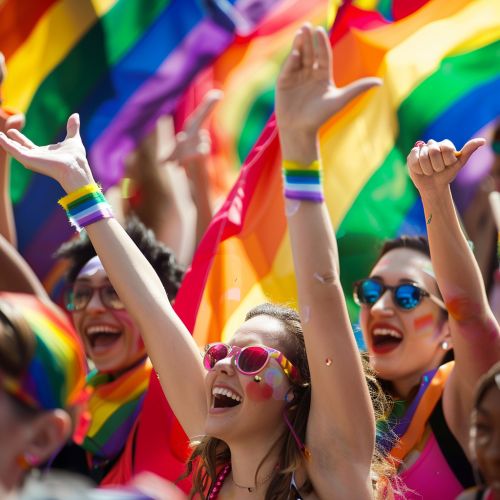LGBTQ representation in media: Difference between revisions
(Created page with "== Introduction == LGBTQ representation in media has evolved significantly over the years, reflecting broader societal changes and contributing to the visibility and acceptance of LGBTQ individuals. This article explores the historical context, current trends, and impact of LGBTQ representation in various forms of media, including film, television, literature, and digital platforms. == Historical Context == === Early Depictions === In the early 20th century, LGBTQ chara...") |
No edit summary |
||
| Line 16: | Line 16: | ||
In recent years, LGBTQ characters have become more prevalent in mainstream cinema. Films like "Brokeback Mountain" (2005), "Moonlight" (2016), and "Call Me by Your Name" (2017) have received critical acclaim and commercial success, signaling a shift towards more inclusive storytelling. | In recent years, LGBTQ characters have become more prevalent in mainstream cinema. Films like "Brokeback Mountain" (2005), "Moonlight" (2016), and "Call Me by Your Name" (2017) have received critical acclaim and commercial success, signaling a shift towards more inclusive storytelling. | ||
[[Image:Detail-92551.jpg|thumb|center|Colorful pride parade with diverse participants celebrating.|class=only_on_mobile]] | |||
[[Image:Detail-92552.jpg|thumb|center|Colorful pride parade with diverse participants celebrating.|class=only_on_desktop]] | |||
== Television == | == Television == | ||
Latest revision as of 17:25, 16 June 2024
Introduction
LGBTQ representation in media has evolved significantly over the years, reflecting broader societal changes and contributing to the visibility and acceptance of LGBTQ individuals. This article explores the historical context, current trends, and impact of LGBTQ representation in various forms of media, including film, television, literature, and digital platforms.
Historical Context
Early Depictions
In the early 20th century, LGBTQ characters and themes were largely absent from mainstream media. When they did appear, they were often portrayed negatively or as stereotypes. The Hays Code, enforced from the 1930s to the 1960s, strictly regulated the depiction of LGBTQ characters in Hollywood films, leading to their marginalization or complete erasure.
The Stonewall Uprising and Its Aftermath
The Stonewall Uprising of 1969 marked a turning point for LGBTQ visibility. This event catalyzed the modern LGBTQ rights movement, leading to increased representation in media. Films like "The Boys in the Band" (1970) and "Cabaret" (1972) began to feature more complex LGBTQ characters, though often still within the confines of tragedy or moral ambiguity.
Film
The New Queer Cinema
The 1990s saw the emergence of the New Queer Cinema movement, characterized by independent films that portrayed LGBTQ lives with greater authenticity and complexity. Directors like Gus Van Sant, Todd Haynes, and Gregg Araki challenged mainstream narratives and offered alternative perspectives on LGBTQ experiences.
Mainstream Acceptance
In recent years, LGBTQ characters have become more prevalent in mainstream cinema. Films like "Brokeback Mountain" (2005), "Moonlight" (2016), and "Call Me by Your Name" (2017) have received critical acclaim and commercial success, signaling a shift towards more inclusive storytelling.


Television
Early Television Representation
Television has historically been more conservative than film in its portrayal of LGBTQ characters. Early representations were often limited to guest appearances or minor roles, frequently reinforcing stereotypes.
The 1990s and Early 2000s
The 1990s and early 2000s saw a gradual increase in LGBTQ representation on television. Shows like "Will & Grace" (1998-2006) and "Queer as Folk" (2000-2005) featured LGBTQ characters in leading roles, helping to normalize LGBTQ identities for mainstream audiences.
Contemporary Television
Today, LGBTQ characters are more visible and diverse than ever before. Series like "Orange is the New Black" (2013-2019), "Pose" (2018-2021), and "Schitt's Creek" (2015-2020) have been praised for their authentic and multifaceted portrayals of LGBTQ individuals.
Literature
Early LGBTQ Literature
LGBTQ themes have been present in literature for centuries, though often coded or hidden due to societal taboos. Works like Oscar Wilde's "The Picture of Dorian Gray" (1890) and Virginia Woolf's "Orlando" (1928) explored LGBTQ identities in subtle ways.
The Gay Liberation Movement
The Gay Liberation Movement of the 1970s spurred a wave of LGBTQ literature that was more explicit and celebratory. Authors like Armistead Maupin, Rita Mae Brown, and James Baldwin wrote openly about LGBTQ experiences, contributing to a growing body of work that reflected the diversity of the community.
Contemporary LGBTQ Literature
Today, LGBTQ literature spans all genres and reaches a wide audience. Authors like Sarah Waters, Andre Aciman, and Ocean Vuong have received critical acclaim for their nuanced and powerful explorations of LGBTQ themes.
Digital Media
Social Media and Online Communities
The advent of social media has revolutionized LGBTQ representation. Platforms like YouTube, Instagram, and TikTok provide spaces for LGBTQ individuals to share their stories and connect with others. Influencers and content creators like Tyler Oakley, Gigi Gorgeous, and NikkieTutorials have amassed large followings and contributed to greater visibility and acceptance.
Streaming Services
Streaming services like Netflix, Hulu, and Amazon Prime have also played a significant role in increasing LGBTQ representation. These platforms offer a wide range of LGBTQ-themed content, from documentaries and original series to films and reality shows.
Impact of LGBTQ Representation
Social and Cultural Influence
LGBTQ representation in media has a profound impact on societal attitudes and perceptions. Positive and diverse portrayals can challenge stereotypes, reduce prejudice, and foster greater understanding and acceptance of LGBTQ individuals.
Psychological Effects
Representation also has significant psychological effects on LGBTQ individuals. Seeing oneself reflected in media can boost self-esteem, provide a sense of belonging, and offer validation. Conversely, negative or stereotypical portrayals can contribute to feelings of isolation and internalized homophobia.
Challenges and Criticisms
Tokenism and Stereotyping
Despite progress, LGBTQ representation in media is not without its challenges. Tokenism, where LGBTQ characters are included superficially or as a form of diversity checkbox, remains an issue. Additionally, stereotypes and one-dimensional portrayals persist, limiting the complexity and authenticity of LGBTQ characters.
Intersectionality
Intersectionality, the interconnected nature of social categorizations such as race, class, and gender, is another critical consideration. Media representations often fail to capture the diverse experiences of LGBTQ individuals who belong to multiple marginalized groups, such as LGBTQ people of color or those with disabilities.
Future Directions
Increasing Diversity
Future efforts in LGBTQ representation should focus on increasing diversity and authenticity. This includes not only more LGBTQ characters but also greater representation of the full spectrum of LGBTQ identities, including non-binary, genderqueer, and asexual individuals.
Behind the Scenes
Representation behind the scenes is equally important. Increasing the number of LGBTQ writers, directors, producers, and executives can lead to more authentic and nuanced storytelling.
